

Ren & Stimpy: The Log Song. Practice with Logarithmic Expressions. Practice with Logarithmic Equations. World Population Clock: 7 Billion People (2014) World Population: Past, Present, and Future (move and expand the bar at the bottom of the chart to navigate through time) The chart above illustrates how world population has changed throughout history.
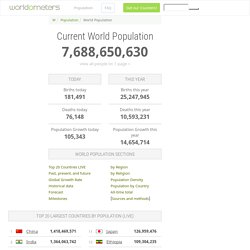
View the full tabulated data. At the dawn of agriculture, about 8000 B.C., the population of the world was approximately 5 million. Over the 8,000-year period up to 1 A.D. it grew to 200 million (some estimate 300 million or even 600, suggesting how imprecise population estimates of early historical periods can be), with a growth rate of under 0.05% per year. A tremendous change occurred with the industrial revolution: whereas it had taken all of human history until around 1800 for world population to reach one billion, the second billion was achieved in only 130 years (1930), the third billion in 30 years (1960), the fourth billion in 15 years (1974), and the fifth billion in only 13 years (1987). Pete Alcorn: The world in 2200. Hans Rosling: Global population growth, box by box. When Will the Human Population Start to Decline? "The power of population is so superior to the power of the Earth to produce subsistence for man, that premature death must in some shape or other visit the human race.
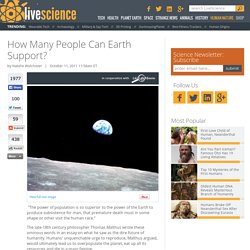
" The late-18th century philosopher Thomas Malthus wrote these ominous words in an essay on what he saw as the dire future of humanity. Humans' unquenchable urge to reproduce, Malthus argued, would ultimately lead us to overpopulate the planet, eat up all its resources and die in a mass famine. But what is the maximum "power of the Earth to produce subsistence," and when will our numbers push the planet to its limit?
More importantly, was Malthus' vision of the future correct? Earth's capacity Many scientists think Earth has a maximum carrying capacity of 9 billion to 10 billion people. One such scientist, the eminent Harvard University sociobiologist Edward O. The 3.5 billion acres would produce approximately 2 billion tons of grains annually, he explained. File:World-Population-1800-2100.svg. Cancel Edit Delete Preview revert Text of the note (may include Wiki markup) Could not save your note (edit conflict or other problem).
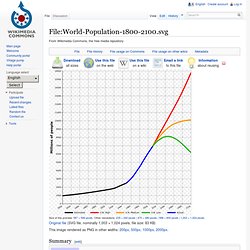
Please copy the text in the edit box below and insert it manually by editing this page. Upon submitting the note will be published multi-licensed under the terms of the CC-BY-SA-3.0 license and of the GFDL, versions 1.2, 1.3, or any later version. See our terms of use for more details. Add a note Draw a rectangle onto the image above (press the left mouse button, then drag and release). Save To modify annotations, your browser needs to have the XMLHttpRequest object.
[[MediaWiki talk:Gadget-ImageAnnotator.js|Adding image note]]$1 [[MediaWiki talk:Gadget-ImageAnnotator.js|Changing image note]]$1 [[MediaWiki talk:Gadget-ImageAnnotator.js|Removing image note]]$1. Aquaponics1. Aquaponics2. Aquaponics Pictures. Incredible Shrinking Dollar. Prologue act one 1.

If Dan shrinks the dollar nine times like this, how big will it be? Will you still be able to see it? 2. Domino Skyscraper. Prologue act one 1.

If you wanted to topple over a domino the size of a skyscraper, how many dominoes would you need? 2. Guess as close as you can. Act two 5. Act three video — one possible answer sequel. Fry's Bank. Prologue act one 1.

How much money does Fry have in his bank account right now? 2. Write down a guess. 3. Act three video — fry's bank balance sequel. Exponential Growth. Exponential Growth If a population has a constant birth rate through time and is never limited by food or disease, it has what is known as exponential growth.
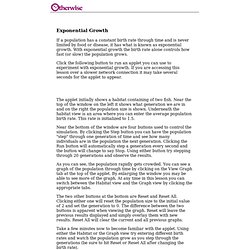
With exponential growth the birth rate alone controls how fast (or slow) the population grows. Click the following button to run an applet you can use to experiment with exponential growth. If you are accessing this lesson over a slower network connection it may take several seconds for the applet to appear. The applet initially shows a habitat containing of two fish. Logistic Growth. Logistic Growth In a population showing exponential growth the individuals are not limited by food or disease.
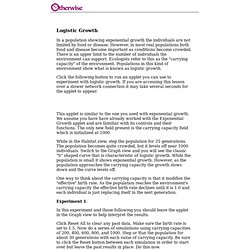
However, in most real populations both food and disease become important as conditions become crowded. Logistic function. Standard logistic sigmoid function A logistic function or logistic curve is a common "S" shape (sigmoid curve), with equation: where For values of x in the range of real numbers from −∞ to +∞, the S-curve shown on the right is obtained (with the graph of f approaching L as x approaches +∞ and approaching zero as x approaches −∞).

The function was named in 1844–1845 by Pierre François Verhulst, who studied it in relation to population growth.[2] The initial stage of growth is approximately exponential; then, as saturation begins, the growth slows, and at maturity, growth stops. The logistic function finds applications in a range of fields, including artificial neural networks, biology (especially ecology), biomathematics, chemistry, demography, economics, geoscience, mathematical psychology, probability, sociology, political science, and statistics. Mathematical properties[edit] Derivative[edit] The standard logistic function (k = 1, x0 = 0, L = 1) has an easily calculated derivative: Thus,